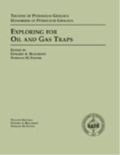Trap spillage
Jump to navigation
Jump to search
| Exploring for Oil and Gas Traps | |

| |
| Series | Treatise in Petroleum Geology |
|---|---|
| Part | Predicting the occurrence of oil and gas traps |
| Chapter | Predicting preservation and destruction of accumulations |
| Author | Alton A. Brown |
| Link | Web page |
| Store | AAPG Store |
Spillage occurs in one of three ways:
- Changes in the trapping geometry
- Changes in the fluid contact due to hydrodynamics
- Reduction in reservoir volume due to postaccumulation cementation
Petroleum loss across faults is considered spillage, not leakage, because faults are part of the trapping geometry. Petroleum shows in spilled accumulations are usually immobile at relatively constant residual saturation over a thick section of the reservoir, with a paleo-fluid contact located near the base of the residual saturation. Petroleum in structurally spilled accumulations is relatively unaltered; oil in hydrodynamically spilled accumulations, on the other hand, is usually altered.
The following changes can occur due to spillage:
- Where charging occurred with large-scale deformation, large volumes of rock not in present-day traps may have acquired residual petroleum saturation as porous intervals occupied former traps.
- Structural growth might have allowed migrating petroleum to escape to the surface. Once lost, the petroleum is no longer available to fill accumulations to economic size, so overall migration efficiency may decline.
- Areas of structural growth after charging can leak if the seal is fractured during deformation (see Leakage).
- Areas with hydrodynamic trapping may have problems with variable oil quality due to biodegradation (see Petroleum destruction).